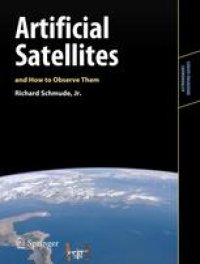
Ebook: Artificial Satellites and How to Observe Them
Author: Richard Schmude Jr. (auth.)
- Genre: Physics // Astronomy
- Tags: Astronomy Observations and Techniques, Popular Science in Astronomy
- Series: Astronomers' Observing Guides
- Year: 2012
- Publisher: Springer-Verlag New York
- Edition: 1
- Language: English
- pdf
Every amateur astronomer - and many non-astronomers - will be familiar with seeing a "star" that shows that characteristic steady slide across the starry background of the sky. Artificial satellites can be seen any night, and some as bright as the planets. But how many of us can identify which satellites or spent launch vehicle casing we are seeing?
Artificial Satellites and How to Observe Them describes all the different satellites that can be observed without optical aid, including of course the International Space Station and the many spy satellites operated by different nations. Richard Schmude looks at them in detail and describes how they can be observed by amateurs, how to recognize them, and even how to predict their orbits.
Artificial satellites have changed since the beginning of the millenium. Several additional countries have launched them. And amateur astronomers have utilized digital cameras in order to image satellites to a resolution of about three feet. This book describes how to recognize, observe, and image satellites. Examples of recent images and how they were made are given. It also offers up-to-date descriptions of the many satellites that are orbiting the Earth and other celestial bodies. Readers can learn how satellites impact our day-to-day lives. In short, Artificial Satellites and How to Observe Them is a detailed and up-to-date overview of artificial satellites and how to study them in the night sky.
Astronomers' Observing Guides provide up-to-date information for amateur astronomers who want to know all about what it is they are observing. This is the basis for the first part of the book. The second part details observing techniques for practical astronomers, working with a range of different instruments.
Every amateur astronomer sees "stars" that aren't natural objects steadily slide across the background of the sky. Artificial satellites can be seen on any night, and some are as bright as the planets. But can you identify which satellite or spent launch vehicle casing you are seeing? Do you know how to image it?
Artificial Satellites and How to Observe Them describes all of the different satellites that can be observed, including communication, scientific, spy satellites, and of course, the International Space Station. Richard Schmude describes how to recognize them and even how to predict their orbits. The book tells how to observe artificial satellites with the unaided eye, binoculars and with telescopes. Many images of artificial satellites taken from Earth are included.
Artificial satellites have changed since the beginning of the twenty-first century. Several additional countries have launched them. And amateur astronomers have utilized digital cameras to image satellites to a resolution of about 1 meter.
Readers of astronomy magazines are aware of these developments but will want to get the complete story. Here it is! Artificial Satellites and How to Observe Them is a detailed and up-to-date overview of artificial satellites. Amateur astronomers will even find out how to make useful scientific observations and join the worldwide community of satellite observers, both professional and amateur, and how to log their work.
Here is a volume that should be a welcome addition to any amateur astronomer's personal library. With it in hand, you can begin sampling right away some of the most interesting manmade objects in the sky.